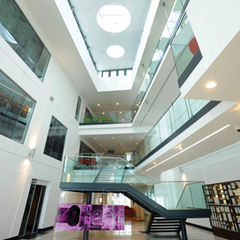The new Public Record Office
 The doors have opened at the new £30 million Public Record Office of Northern Ireland in Belfast. Emma Blee went along to find out more about the historic documents it houses and the services available.
The doors have opened at the new £30 million Public Record Office of Northern Ireland in Belfast. Emma Blee went along to find out more about the historic documents it houses and the services available.
“The first thing people will be aware of when they visit is the sheer scale of the building and its openness and airiness,” remarks Lawrence Stanford.
As PRONI’s Head of New Accommodation, he was tasked with overseeing the move to the Titanic Quarter. The Executive invested almost £30 million in the new offices and construction work began in November 2008.
The new building is around twice the size of the former Balmoral Avenue site. It contains 40km of historic documents, ranging from Cabinet meeting minutes to the records of a local corner shop. The oldest item is a 13th century Papal bull. All three million records held within the building are stored in four specially designed vaults at 15-18°C, compared to twenty rooms at the old site.
A public search room including 52 computer desks and a separate reading room seats 78 people. The ground floor also has a café and vast space for exhibitions.
Transporting such a vast number of documents was no easy task but Stanford says the move went “exceptionally smoothly”.
“We closed to the public on 3 September [2010] and then started to move the records the week after that. We didn’t expect to get everything in until the end of February but we were finished at the start of January and that moved the actual opening date well forward for us as we had initially talked about May or June,” he comments.
Director Aileen McClintock says the new building is a huge change from the old offices: “The building at Balmoral Avenue was very much a building of its time in the 1970s but it was no longer fit for purpose, either in terms of the public service we could deliver there or for the records.
“We had outgrown the site in every possible way. This is just what we needed and it gives us growing room for the future.”
She believes that the public will also benefit from better facilities: “They can do an online search and use the reading room. The records are better organised, we’ve done a massive stock take and we have much better electronic shelving so it should be a quicker service.”
While the public didn’t get far beyond a reading room at Balmoral Avenue, Stanford says that the concept of “openness and flexibility” is at the heart of the new offices.
“It’s about attracting people who may not actually be PRONI users into the building. They can come in, look around, use the café and the Wifi service and view the exhibitions and art pieces we have. If we can hook them at that stage, they might become PRONI users,” he explains.
He has noticed a big jump in the number of people interested in genealogy and local history following on from programmes such as ‘Who Do You Think You Are?’
It’s such a popular area now. It isn’t always as easy as coming in and pushing a button and finding out your family history, though, as it can take years. But I think when people come in they do get hooked on it,” he quips.
PRONI’s Head of Public Services, Stephen Scarth, argues that legislation such as the Freedom of Information Act means that citizens are “very well informed” about the different types of information they can access. However, he has noticed a change in the way the public want to access records.
“At one point the internet was just an add-on but now we’re getting hundreds of thousands of visitors a year,” he remarks. “There’s a greater appetite from the public to access documents and fast. The old days of looking through catalogues and spending days trying to find a particular item are gone. People aren’t prepared to wait now.”
The opening exhibition at PRONI is ‘A Century of Change, Conflict and Transformation, 1911-2011’.






